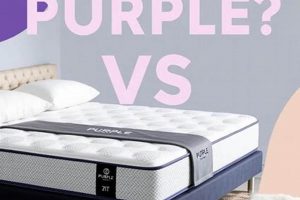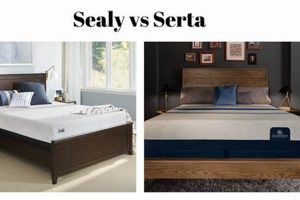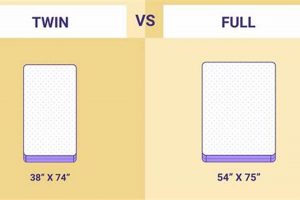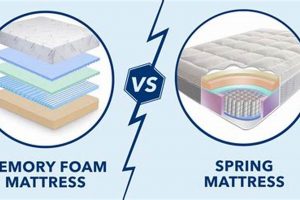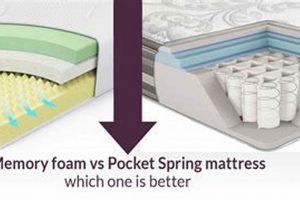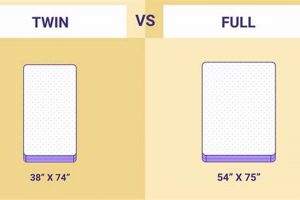The selection of a sleep surface involves navigating a landscape of materials and construction methods. Two prominent options present themselves: viscoelastic polyurethane foam and traditional innerspring designs. Understanding the properties of each is essential for making an informed decision.
Material composition and construction influence factors such as pressure relief, support, temperature regulation, and motion isolation. These considerations impact sleep quality and overall physical well-being. Examining the historical evolution of sleep surfaces reveals a continuous pursuit of enhanced comfort and ergonomic support.
This analysis will delve into the characteristics of each type of sleeping surface, exploring their respective advantages and disadvantages regarding comfort, durability, and suitability for diverse sleep preferences.
Considerations for Selecting a Sleep Surface
Choosing between different sleep surface types requires careful evaluation of individual needs and preferences. The following considerations can guide the decision-making process.
Tip 1: Assess Pressure Relief Requirements. Viscoelastic polyurethane foam conforms to the body’s contours, distributing weight and reducing pressure points. Individuals experiencing joint pain or seeking enhanced spinal alignment may find this advantageous. Traditional innerspring designs offer less contouring and may concentrate pressure in certain areas.
Tip 2: Evaluate Support Needs. Traditional innerspring mattresses generally provide more robust overall support due to the coil system. However, the support offered by viscoelastic polyurethane foam mattresses varies depending on density and construction. Assess individual body weight and sleeping position to determine the appropriate level of support.
Tip 3: Account for Temperature Sensitivity. Viscoelastic polyurethane foam is known for retaining heat. Consider opting for gel-infused or open-cell varieties, which promote airflow. Innerspring designs typically offer better ventilation due to the open space within the coil structure.
Tip 4: Factor in Motion Isolation. If sharing a bed, motion isolation is a key consideration. Viscoelastic polyurethane foam excels at absorbing movement, minimizing disturbance to a sleeping partner. Innerspring systems transmit motion more readily.
Tip 5: Research Durability Expectations. The longevity of each sleep surface type varies depending on material quality and usage. Higher-density viscoelastic polyurethane foam generally lasts longer than lower-density options. Innerspring durability depends on the gauge and construction of the coils.
Tip 6: Consider Budgetary Constraints. The initial cost of the different sleep surface types can vary significantly. Viscoelastic polyurethane foam mattresses often command a higher price point, although more affordable options are available. Innerspring mattresses tend to offer a wider range of price points.
Tip 7: Investigate Trial Periods and Warranties. Reputable manufacturers offer trial periods, allowing consumers to test the sleep surface before committing to a purchase. Warranties provide protection against manufacturing defects and premature sagging. Review the terms and conditions carefully.
By carefully evaluating these factors, individuals can make an informed decision that aligns with their specific needs and preferences, ultimately contributing to improved sleep quality and overall well-being.
These considerations should inform the ultimate decision regarding sleep surface selection, but additional research into specific models and brands is also recommended.
1. Conforming
The ability of a sleep surface to conform to the body’s contours is a primary differentiator between viscoelastic polyurethane foam and traditional innerspring mattresses. This characteristic directly influences pressure distribution, spinal alignment, and overall comfort.
- Pressure Point Relief
Viscoelastic polyurethane foam’s conforming properties allow it to distribute body weight more evenly, reducing pressure on sensitive areas such as the hips, shoulders, and spine. This can alleviate discomfort for individuals experiencing joint pain or pressure sensitivity. In contrast, traditional innerspring mattresses, with their more rigid surface, may concentrate pressure on these points.
- Spinal Alignment
Proper spinal alignment is crucial for preventing back pain and promoting restful sleep. Viscoelastic polyurethane foam conforms to the natural curvature of the spine, providing support and maintaining proper alignment. The level of support offered by innerspring mattresses varies depending on the coil system and construction. Some may not adequately conform to the spine, leading to misalignment.
- Surface Area Contact
Conforming increases the surface area of contact between the body and the mattress. This broader contact area distributes weight more evenly, minimizing localized pressure and enhancing overall comfort. The limited conforming ability of innerspring mattresses results in a smaller contact area and potentially higher pressure concentrations.
- Individualized Support
The conforming nature of viscoelastic polyurethane foam allows it to adapt to individual body shapes and sleeping positions. This individualized support ensures that different areas of the body receive the appropriate level of pressure relief and support. Innerspring mattresses offer a more uniform level of support across the entire surface, which may not be ideal for individuals with varying support needs.
The degree to which a sleep surface conforms directly impacts the sleeping experience. Viscoelastic polyurethane foam’s conforming ability offers distinct advantages in terms of pressure relief, spinal alignment, and individualized support, whereas traditional innerspring mattresses generally provide a less conforming and more uniform sleeping surface. The selection of a sleep surface should consider these differences in relation to individual comfort preferences and physical needs.
2. Supportive
The term “supportive” when applied to sleep surfaces signifies the capacity to maintain proper spinal alignment and distribute body weight evenly, contributing to a comfortable and restful sleep experience. This characteristic differentiates viscoelastic polyurethane foam and traditional innerspring mattresses significantly.
- Core Stability
Viscoelastic polyurethane foam achieves support by conforming to the body’s shape, filling in gaps and distributing weight across a broader surface area. The density of the foam plays a critical role; higher densities offer greater resistance and, therefore, more substantial support. In contrast, innerspring mattresses rely on the coil system for support. The gauge (thickness) and configuration of the coils determine the firmness and support level. Softer coils compress more readily, providing less support, while firmer coils offer greater resistance.
- Edge Support
Edge support refers to the stability of the mattress perimeter. Strong edge support prevents sagging and allows individuals to utilize the entire sleep surface without feeling like they will roll off. Viscoelastic polyurethane foam mattresses may lack robust edge support, particularly those with less dense foam near the edges. Innerspring mattresses often incorporate reinforced edges, using thicker coils or foam encasement to enhance edge stability.
- Weight Distribution
Effective support involves distributing body weight evenly across the mattress surface, preventing pressure points and promoting healthy circulation. Viscoelastic polyurethane foam excels at distributing weight due to its conforming properties. It minimizes pressure concentrations, particularly in areas like the hips and shoulders. Innerspring mattresses, depending on their construction, may not distribute weight as effectively, leading to localized pressure and discomfort.
- Long-Term Support Integrity
The ability of a sleep surface to maintain its supportive properties over time is crucial for long-term comfort and spinal health. Viscoelastic polyurethane foam can lose its supportive qualities over time due to compression and degradation of the foam. The lifespan and support integrity depend heavily on the foam’s density and quality. Innerspring mattresses can also experience a decline in support due to coil fatigue and sagging. The quality of the coils and the overall mattress construction determine their long-term durability.
Therefore, the level of support provided depends on density and construction of the foam for viscoelastic polyurethane, or the coil system’s design and integrity for innerspring. It is essential to consider these differences in relation to individual body weight, sleeping position, and long-term needs when choosing between these sleep surface types.
3. Temperature
Temperature regulation during sleep is a crucial factor influencing sleep quality and overall comfort. Different sleep surfaces exhibit varying thermal properties, affecting the sleeping environment. Viscoelastic polyurethane foam, due to its dense structure, tends to retain heat more readily than traditional innerspring mattresses. This characteristic can lead to a warmer sleeping experience, potentially causing discomfort for individuals prone to overheating or residing in warmer climates. In contrast, the open structure of innerspring mattresses facilitates airflow, promoting better ventilation and dissipating heat more effectively. This can result in a cooler sleeping environment, which may be preferable for those who sleep hot or live in warmer regions.
Modifications to viscoelastic polyurethane foam, such as the incorporation of gel infusions or open-cell structures, aim to mitigate heat retention. Gel-infused viscoelastic polyurethane foam is designed to absorb and dissipate heat, while open-cell structures allow for greater airflow within the foam, reducing heat buildup. However, the effectiveness of these modifications can vary depending on the specific product and ambient temperature. Traditional innerspring mattresses, by virtue of their construction, naturally offer superior ventilation compared to even the most advanced viscoelastic polyurethane foam designs. The space between the coils allows for continuous airflow, preventing heat from accumulating within the mattress.
The choice between sleep surfaces should consider individual thermal preferences and environmental factors. Individuals who tend to sleep hot or live in warm climates may find innerspring mattresses more comfortable due to their superior ventilation. Conversely, those who prefer a warmer sleeping environment or reside in cooler climates might find viscoelastic polyurethane foam acceptable, particularly if it incorporates cooling technologies. Ultimately, selecting a sleep surface with appropriate temperature regulation capabilities is essential for optimizing sleep quality and comfort.
4. Durability
Durability, in the context of sleep surfaces, refers to the ability of a mattress to maintain its original form, support, and comfort characteristics over an extended period. The inherent materials and construction methodologies employed in viscoelastic polyurethane foam and traditional innerspring mattresses dictate their respective lifespans and resistance to degradation. Understanding these factors is paramount for consumers seeking a long-term investment in their sleep quality.
Viscoelastic polyurethane foam mattresses, primarily composed of synthetic materials, are susceptible to gradual compression and loss of density over time. Higher-density foam formulations generally exhibit greater resistance to these effects, resulting in a longer lifespan. However, factors such as usage patterns, body weight, and environmental conditions can influence the rate of degradation. Conversely, innerspring mattresses rely on a network of metal coils for support. The gauge and temper of these coils, along with the quality of the surrounding upholstery materials, determine the mattress’s ability to withstand constant pressure and maintain its structural integrity. Coil fatigue, sagging, and the breakdown of comfort layers are common indicators of decreased durability in innerspring models.
The practical significance of understanding durability differences lies in aligning mattress selection with individual needs and expectations. Consumers prioritizing long-term value and consistent performance may find higher-quality viscoelastic polyurethane foam or hybrid models (combining foam and coils) to be a worthwhile investment. Those seeking a more budget-friendly option with potentially shorter lifespan may opt for a traditional innerspring mattress. Ultimately, a thorough assessment of material composition, construction techniques, and warranty provisions is crucial for evaluating the long-term durability and value proposition of any sleep surface.
5. Motion Isolation
Motion isolation refers to a sleep surface’s ability to absorb movement, preventing its transfer across the mattress. This characteristic is particularly relevant for individuals sharing a bed, as it minimizes disturbances caused by a partner’s movements during sleep. Significant differences exist in the motion isolation capabilities of viscoelastic polyurethane foam and traditional innerspring mattresses.
Viscoelastic polyurethane foam excels at absorbing motion due to its dense, conforming nature. When pressure is applied to one area of the mattress, the foam compresses locally, minimizing ripple effects and preventing the transfer of movement to other parts of the surface. This localized compression reduces the likelihood of a sleeping partner being disturbed by tossing, turning, or getting in and out of bed. In contrast, traditional innerspring mattresses tend to transmit motion more readily. The interconnected coils within the mattress act as a network, transferring movement across the entire surface. When one coil is compressed, the surrounding coils are also affected, resulting in a more noticeable transfer of motion. For example, a person getting out of bed on one side of an innerspring mattress may cause a noticeable bounce or vibration on the other side, potentially disturbing their sleeping partner.
The degree of motion isolation significantly impacts sleep quality for co-sleeping individuals. Selecting a sleep surface with effective motion isolation, such as viscoelastic polyurethane foam, can contribute to more restful and undisturbed sleep. While innerspring mattresses may offer other benefits, their limited motion isolation capabilities should be carefully considered when sharing a bed. Hybrid mattresses, combining foam and coil technologies, attempt to balance motion isolation with other desired characteristics, but their effectiveness varies depending on the specific design and materials used.
6. Cost
The financial investment associated with sleep surfaces represents a significant consideration for consumers. The price differential between viscoelastic polyurethane foam and traditional innerspring mattresses can be substantial, influencing purchasing decisions and accessibility to various levels of comfort and support.
- Initial Purchase Price
Viscoelastic polyurethane foam mattresses often exhibit a higher initial purchase price compared to traditional innerspring models. This difference stems from material costs, manufacturing processes, and perceived value associated with enhanced comfort and pressure relief. Entry-level innerspring mattresses can be significantly more affordable, presenting a viable option for budget-conscious consumers.
- Long-Term Value
While the initial cost may be lower for innerspring mattresses, the lifespan and durability must be factored into the long-term value equation. Lower-quality innerspring models may require more frequent replacement due to sagging or coil breakdown, potentially offsetting the initial cost savings. Higher-density viscoelastic polyurethane foam mattresses, though initially more expensive, may offer greater longevity and consistent performance over time.
- Material Composition and Construction
The materials used in both types of mattresses directly influence their cost. Higher-quality foams, such as those with CertiPUR-US certification, often command a premium. Similarly, in innerspring mattresses, the gauge and type of coils, as well as the quality of the upholstery layers, contribute to the overall price. Hybrid mattresses, combining foam and coil technologies, typically fall within a mid-range price point, reflecting the blended material costs.
- Additional Features and Technologies
Features such as gel infusions, open-cell foam structures, and advanced coil designs can increase the cost of both viscoelastic polyurethane foam and innerspring mattresses. These technologies are often marketed as enhancing comfort, temperature regulation, or support. Consumers should carefully evaluate the purported benefits of these features against their price premium to determine their value proposition.
The financial implications associated with sleep surface selection are multifaceted, encompassing initial purchase price, long-term value, material composition, and technological advancements. A comprehensive assessment of these factors, aligned with individual budgetary constraints and sleep preferences, is essential for making an informed and cost-effective decision when choosing between viscoelastic polyurethane foam and traditional innerspring mattresses.
Frequently Asked Questions
The following addresses common inquiries and clarifies misconceptions surrounding viscoelastic polyurethane foam and traditional innerspring mattresses.
Question 1: What constitutes a “regular” mattress in this comparison?
The term “regular mattress” generally refers to traditional innerspring mattresses, characterized by a core of metal coils providing support, typically covered with upholstery layers for comfort.
Question 2: Does viscoelastic polyurethane foam always sleep hotter than innerspring mattresses?
Viscoelastic polyurethane foam does have a tendency to retain heat more than innerspring mattresses due to its density. However, innovations like gel infusions and open-cell structures can improve breathability and mitigate heat retention.
Question 3: Are all viscoelastic polyurethane foam mattresses created equal in terms of durability?
No. The density of the viscoelastic polyurethane foam is a primary indicator of durability. Higher-density foam generally withstands compression and degradation better than lower-density foam, resulting in a longer lifespan.
Question 4: Which type of mattress is better for individuals with back pain?
The optimal choice varies based on the individual’s specific needs and spinal condition. Viscoelastic polyurethane foam’s conforming properties can provide pressure relief and spinal alignment for some, while others may find the firmer support of an innerspring mattress more beneficial. Consulting a healthcare professional is recommended.
Question 5: Is a higher price always indicative of superior quality in sleep surfaces?
While price often correlates with quality, it is not a definitive indicator. Material composition, construction techniques, and brand reputation all contribute to the overall value of a mattress. Comparing specifications and reading reviews is crucial.
Question 6: How can one determine if a mattress is truly “motion isolating?”
Motion isolation can be assessed by testing the mattress in person, if possible. Applying pressure to one area and observing the movement transfer to other areas provides a practical indication of its motion isolation capabilities. Reading reviews from co-sleeping individuals can also provide valuable insights.
In summary, the selection between viscoelastic polyurethane foam and innerspring mattresses involves careful evaluation of individual needs, preferences, and budgetary considerations. No single type is universally superior; the optimal choice depends on aligning mattress characteristics with personal requirements.
The subsequent section provides a conclusion and final thoughts on the analysis.
Conclusion
This exploration has illuminated the distinct characteristics of viscoelastic polyurethane foam and traditional innerspring mattresses, often framed as “memory foam vs regular mattress.” Critical factors such as conforming ability, support, temperature regulation, durability, motion isolation, and cost have been dissected to provide a comprehensive comparative analysis. The suitability of each option hinges on individual needs, sleep preferences, and budgetary limitations.
Ultimately, the decision regarding “memory foam vs regular mattress” requires a thorough self-assessment. Prospective buyers are encouraged to leverage the information presented to make an informed choice, prioritizing personal comfort and long-term sleep health. Continued advancements in sleep technology suggest that the evolution of mattress design will persist, offering increasingly refined options to meet diverse consumer demands.


